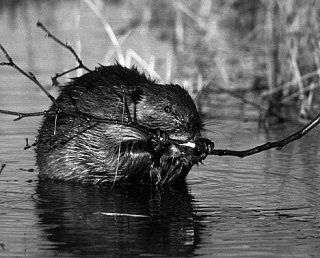Buried in some of San Juan County’s wet woodlands are remnants of hundreds of beaver dams. Inconspicuous shallow berms of humus rich silt are all that remains of our original wetland engineers, who did not survive the establishment of fur trading posts at Fort Langley and San Juan Island in the 1820s to 1850s.
Beavers on the mainland are now rebounding. Lodges and gnawed tree stumps have also recently appeared in wetlands on Orcas, Cypress and some smaller islands. Homeowners may fear for their fruit trees, but finding ways to live with beavers — wrapping fruit tree trunks with chicken wire, and fencing beavers out of culverts and drains — can be a good thing for the islands’ amphibians, birds, and bats.
Beavers create new ponds, or raise the water level of existing wetlands, by using a kind of adobe: mud and chunks of turf slapped onto a thatch of sticks. Beaver dams are never watertight despite the beavers’ nightly efforts to plug leaks. Water trickles through in summer and during the rainy season, spills over the top. This prevents heavy blooms of algae, keeps water oxygenated, and even allows for seasonal fish passage!
Behind a beaver dam, water backs up and spreads out over the landscape, creating a large wetted area. This favors trees beavers find tasty: red alder, black cottonwood and quaking aspen. Indeed, aspens grow faster and spread more aggressively when beavers are harvesting them. This may be why we have so few aspen groves in the islands today. Without beavers, alders and conifers out-compete aspens. You can see a relic aspen grove from Ferry Road just south of the turnoff to Odlin Park on Lopez.
Before 1850, most of the standing water on the islands (with the exception of our few natural glacial lakes, such as Hummel) was in beaver ponds. Since then people have replaced beaver ponds with dug ponds. Dug ponds with clay bottoms are usually deeper and more watertight than beaver ponds. Water gets warmer, accumulates nutrients, and grows “green slime” — perfect habitat for voracious recently introduced Eastern bullfrogs, and mosquitoes. Eventually dug ponds silt up and must be dredged or replaced.
Beavers abandon their dams after 5-10 years and build new ones elsewhere. After one or two winters with maintenance, beaver dams collapse and become compost, and the freshly exposed pond bottoms become verdant meadows, and eventually wet woodlands.
Russel Barsh (RLBarsh@gmail.com) and Madrona Murphy work for the Lopez-based nonprofit conservation biology laboratory KWIÁHT. They recommend archaeologist Bryony Cole’s recent book, “Beavers in Britain’s Past.”



